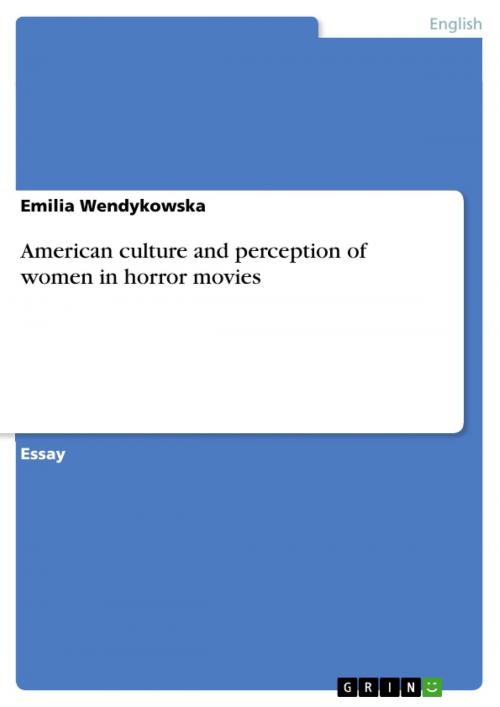American culture and perception of women in horror movies
Nonfiction, Entertainment, Drama, Anthologies| Author: | Emilia Wendykowska | ISBN: | 9783656228585 |
| Publisher: | GRIN Publishing | Publication: | July 2, 2012 |
| Imprint: | GRIN Publishing | Language: | English |
| Author: | Emilia Wendykowska |
| ISBN: | 9783656228585 |
| Publisher: | GRIN Publishing |
| Publication: | July 2, 2012 |
| Imprint: | GRIN Publishing |
| Language: | English |
Essay from the year 2012 in the subject American Studies - Culture and Applied Geography, grade: A, University of Malta, language: English, abstract: Horror genre has its origins in the gothic 19th century novels like Marry Shelley's Frankenstein (1818) or John Polidori's The Vampire (1819). Even though horror movie is a typical European genre, it has a long history in American cinema dating back to 1915 silent movie Les Vampires by Freuillade and to one of the first sound movies from 1931, Tod Browning's famous Dracula. Horror movies may be put into three categories: ones that contain the supernatural elements, in which vampires, ghosts, witchcraft appears; psychological horror, which relies on characters' fears, their guilt or beliefs; and massacre movies, with scenes of slaughter, brutality and rough treatment (Cinema Studies 184). Although horror movies, as an element of mass culture, may be perceived as simplistic, predictable, lacking depth and simply being an unworthy for analysis, there is a great deal of films that in its content reflect the contemporary problems that occurred in the American society. While many critics consider horror genre as a 'low culture,' one must not fail to notice that its significance is enormous. One can sense an inextricable link between film and social concerns, since the role of the film is to project certain fears and concerns of contemporary society as well as to help people to resolve them. As Prawer observed: 'If the terror film is thus connected to our social concerns, it also, paradoxically, helps us to cope with our ordinary life by jolting us out of it' (60). A popular opinion has it that the popularity of horror movies increases along with the disturbance experienced by the society. Since the 20th century is perceived as the era of the constant social upheaval, the history of the horror movie equals the history of the anxiety (Wells 3); hence, the time the cultural chaos erupts, the audience turns to horror movies as a means that liberates them from their anxiety. As Phillips asserts, 'anxiety tends to promote a sense of helplessness; fear, on the other hand, provides an impetus for change' (9). Thus, the fear evoked by the slasher film, one is forced to invent new ways of coping with his or her difficulties, since a typical way of thinking will occur not only problematic but also troublesome.
Essay from the year 2012 in the subject American Studies - Culture and Applied Geography, grade: A, University of Malta, language: English, abstract: Horror genre has its origins in the gothic 19th century novels like Marry Shelley's Frankenstein (1818) or John Polidori's The Vampire (1819). Even though horror movie is a typical European genre, it has a long history in American cinema dating back to 1915 silent movie Les Vampires by Freuillade and to one of the first sound movies from 1931, Tod Browning's famous Dracula. Horror movies may be put into three categories: ones that contain the supernatural elements, in which vampires, ghosts, witchcraft appears; psychological horror, which relies on characters' fears, their guilt or beliefs; and massacre movies, with scenes of slaughter, brutality and rough treatment (Cinema Studies 184). Although horror movies, as an element of mass culture, may be perceived as simplistic, predictable, lacking depth and simply being an unworthy for analysis, there is a great deal of films that in its content reflect the contemporary problems that occurred in the American society. While many critics consider horror genre as a 'low culture,' one must not fail to notice that its significance is enormous. One can sense an inextricable link between film and social concerns, since the role of the film is to project certain fears and concerns of contemporary society as well as to help people to resolve them. As Prawer observed: 'If the terror film is thus connected to our social concerns, it also, paradoxically, helps us to cope with our ordinary life by jolting us out of it' (60). A popular opinion has it that the popularity of horror movies increases along with the disturbance experienced by the society. Since the 20th century is perceived as the era of the constant social upheaval, the history of the horror movie equals the history of the anxiety (Wells 3); hence, the time the cultural chaos erupts, the audience turns to horror movies as a means that liberates them from their anxiety. As Phillips asserts, 'anxiety tends to promote a sense of helplessness; fear, on the other hand, provides an impetus for change' (9). Thus, the fear evoked by the slasher film, one is forced to invent new ways of coping with his or her difficulties, since a typical way of thinking will occur not only problematic but also troublesome.















